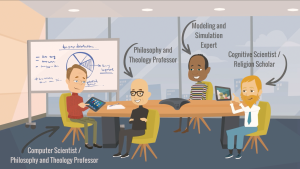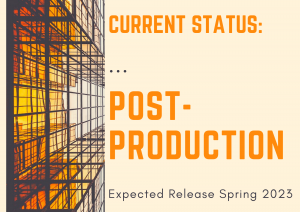 Over three years a team of religion scholars and computer experts team up to create models and simulations of religion. This team calls their endeavor the Modeling Religion Project (the MRP), and their work takes place at the Virginia Modeling, Analysis, & Simulation Center in Virginia USA, the Center for Mind and Culture in Boston USA, and the Center for Modeling Social Systems in Kristiansand, Norway. These religion and computer specialists, starting from very different understandings and methodologies, set out to combine their knowledge and apply the methods of computer simulation to the scientific study of religion in order to test theories about the social world.
Over three years a team of religion scholars and computer experts team up to create models and simulations of religion. This team calls their endeavor the Modeling Religion Project (the MRP), and their work takes place at the Virginia Modeling, Analysis, & Simulation Center in Virginia USA, the Center for Mind and Culture in Boston USA, and the Center for Modeling Social Systems in Kristiansand, Norway. These religion and computer specialists, starting from very different understandings and methodologies, set out to combine their knowledge and apply the methods of computer simulation to the scientific study of religion in order to test theories about the social world.
The MRP team recognizes the power of computer simulation and wants modeling and simulation to be accessible to people without computer programming experience, so they also aim to create a simulation platform specifically designed to help non-modelers build models to test theories. While working in Norway, the team devises a plan for their models to inform policymakers about the potential of computer modeling to explore different applications of various public policies. Back in Virginia and Boston, the team meets with an international relations expert to better understand religious violence and develop models to help counter religious radicalization and terrorism through policy. When they collaborate with a group of archaeologists, the team learns more about 3D archeological modeling and witness how modeling makes history more accessible.
Later, the MRP team consults humanities scholars to model complex social and religious processes, which eventually leads to the application of modeling to the refugee crisis in Lesvos, Greece. After using modeling and simulation to better understand aspects of immigration and religion, the team returns back to Virginia to test their simulation platform for people without programming experience. In Boston, they present the findings of their studies to other scholars, arguing that modeling and simulation draws social scientific theories forward into a new realm of precision and harmony with data.
As the MRP team concludes their 3-year project, they reflect on the challenges and benefits of interdisciplinary cooperation and communicating their sophisticated work to the general public. The team acknowledges that, while modeling and simulation is effective at testing academic theories, the methods must be further refined to be accessible for non-modelers, young people, and even disabled or spectrum-disordered people, hinting at their future plans.


